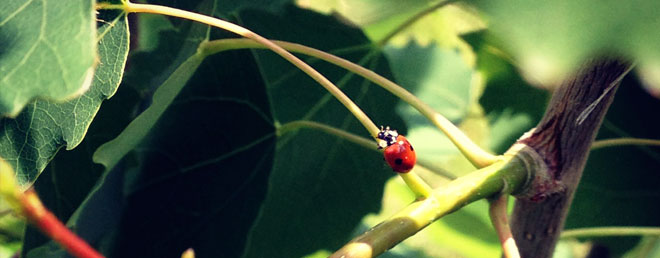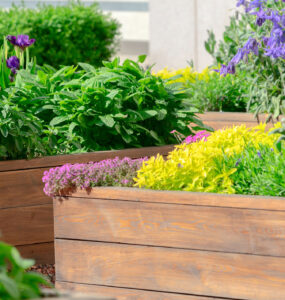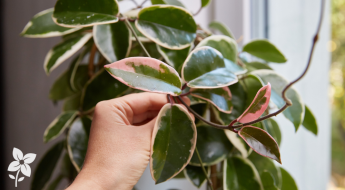Ladybugs 101
by Rob Sproule
The past few years have seen a lot of buzz for a pretty predator called Ladybugs. We’ve all heard that they’re one of the best bugs to have in your garden, but how do you get them there and, once they’ve come, how do you convert opportunistic visitors into an aphid smashing army that sets up permanent barracks?
Entomologists wince at the term “ladybug.” Ladybeetles – their politically correct name – actually aren’t a true bug. Of the over 5000 species of the insect family Coccinellidae, 500 of them hail from North America.
Ladybugs are arguably the world’s most beloved insect, and almost all cultures believe that killing them is inviting misfortune. Depending on where you are, if a ladybeetle lands on your hand, superstition dictates that you’re either getting new gloves (England), getting married within a year (Belgium, and if you’re a single woman), or that you can expect any ailment you have to fly away with it (France). In the 1800s, doctors were even known to jam them into cavities to alleviate toothaches or prescribe them to treat measles.
During a particularly nasty aphid infestation in the Middle Ages, Europeans prayed to the Virgin Mary to save their crops. Legions of ladybugs appeared, and they were henceforth named “Bug of our Lady” in tribute.
Why are they Beneficial
Ladybugs are so vicious that I’m glad they’re on our side. They’re aphid eating machines, devouring up to 50 a day and about 5000 over their lifetime. Depending on the ladybeetle species, scale and other soft bodied pests are doomed, too.
Ladybeetles can have 3-4 life cycles in a year, with females laying dozens of eggs a day on the undersides of leaves. Emerging larvae look like tiny black caterpillars with an orange blotch. Be careful not to confuse them with bad critters.
If aphids run short they can live on pollen and nectar for a short time, after which they will cannibalize each other before starving or seeking protein elsewhere. They’ve been farmers’ friends for centuries and have proved to arguably be the most useful agricultural insect in the world.
Getting them into your Yard
If you want a larger population of ladybeetles in your yard, you can either buy them or attract them. The former option is quick and easy but you’ll need to know a few things before opening that bag, and the latter option may require some minor garden retrofitting.
Like all critters, ladybeetles have favourite plants. Adding herbs like dill or cilantro, annuals like sunflowers or zinnias, and perennials like yarrow, Solidago, or Alyssum will help lure them to your side of the fence.
The other crucial aspect to attracting ladybugs, which some of you may not like, is food. Aphid free yards are also ladybug free; they will move on until they find a food source. If you want to maintain your ladybug population, you’ll need to look the other way at the odd aphid (unless the infestation becomes severe), so your troops don’t starve.
To get your army started, you can buy ladybugs by the hundreds at large garden centres. Call around first to make sure they carry them and check the bag; they will have an expiration date.
There are a few tricks to releasing them to ensure they don’t all scatter. Keep them refrigerated (not frozen) until you’re ready to use them. The cold will slow down their metabolism so they will live longer.
Wait until twilight as they tend to fly during sunlight hours; it will give them a chance to get comfortable before the sun makes them restless. They will be thirsty so spray water across the release area, and take the time to sprinkle them over a large (preferably aphid infested) area. If you dump them all in one spot, or just open the bag and go watch t.v., most will have flown away by the first commercial break.
A ladybug’s dream garden has a wide variety of plants in it (including those listed above), which are mature enough for their leaves to overlap. It’s also watered regularly enough that there is access to droplets to drink. If you keep you garden on the dry side, consider submerging a small container of water with rocks and twigs to land on.
Keeping them in your Yard
When a gardeners sees aphids, the urge to kill-kill is almost instinctual. Every day I see people come into the greenhouse, aphid strewn zip-loc in hand, looking for the most toxic chemical on the shelf to douse their yard with. While this is the fastest way to kill aphids, it’s also a trap.
Once you establish a viable ladybeetle population (ie. see them hanging out on plants throughout the year), resist the urge to spray pesticides or you will have to start all over again. Spraying pesticides is chemical warfare and wipes out all insects, good and bad. The aphids will re-establish their population much faster and, before long, they will be worse than before.
It takes a long time to establish a viable ladybug army, but it’s priceless once you have it. When aphids strike, trust that your resident army will deal with it. It won’t be overnight, as they may need to bring in reinforcements, but they will win.
Eventually, your yard will become a balanced eco-system wherein predator and prey endlessly skirmish but neither side eradicates the other. Ladybugs, not wanting their kids to starve, will only lay eggs on aphid infested plants.
Don’t clean up your perennial beds entirely in the fall. Ladybugs live up to 3 years and overwinter amongst old leaves near the soil, at the base of a tree, or under rocks. Dozens or hundreds often huddle together, and if you find one of these spots, make sure to leave it unmolested. Unfortunately, slugs also love these spots, so make sure to check for their caviar-looking egg clusters before the snow flies.
















